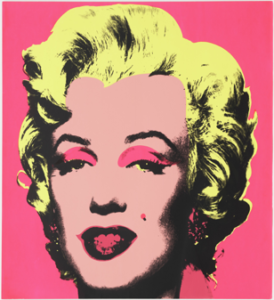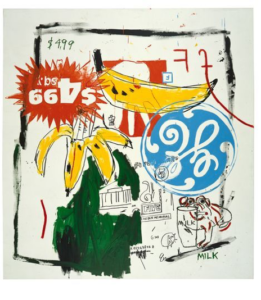Zachary Troyano
Art 1010 Final Paper
Prof. Shaw
11/27/18
Both Andy Warhol and Jean-Michel Basquiat explored the depths of American culture in their respective art work. Warhol first met Basquiat when out to dinner at a restaurant with curator Henry Geldzahler, when Basquiat approached Warhol to sell him postcards with his artwork on them.1 In their art, both artists represented and created a unique American identity they explored within the overarching themes of their work. Warhol, significantly older than Basquiat, started his career earlier, in the 1960’s. His art focused greatly on the rapidly changing and turbulent landscape of America during that time. Advertisements interested him greatly, he saw them every day as America was quickly evolving into a capitalist empire. His artwork reflected the changes he saw, often he would use corporate symbols and household objects and turn them or transfuse them into art. Along with his exploration of overwhelming advertisements, Warhol also focused his art on celebrity culture, another emerging staple of the time. America, and more specifically, American media, had a rapidly growing and intertwined relationship with celebrities. Warhol saw this obsession and chose to capture it and further develop that unique American identity. He would make large scale prints of the faces of celebrities and notable figures of the time. Often, he would distort the colors of their face and alter certain pigments to cast them in a different or unfamiliar light. After Warhol had cemented his name in art history, Basquiat entered the art world in the 1980’s as a street and graffiti artist. Basquiat gained instant notoriety in the art community and he soon found himself a major focus in the art scene. His work explored institutionalized racism in America and social hierarchies based on skin color. He also worked in themes of power structure dynamics and oppression. Jean-Michel Basquiat and Andy Warhol created a unique American identity within their art, both individually and in their joint collaborations.

“Marilyn”, Andy Warhol 1967
This print of Marilyn Monroe is an example of Warhol creating an unique American identity within his art. Marilyn Monroe was arguably the most famous actress in the world during the 1950’s and 1960’s. She was featured on the cover of magazines, starred in movies, even allegedly had an affair with President John F. Kennedy. In every way, she was a staple of American culture during the time Warhol was making his art. In this print, Warhol chooses only to include Monroe’s head, almost like a celebrity headshot, and saturates and alters the color on her face to make her face slightly less familiar and different from what we are used to seeing her as. Often Warhol replicated the print several times and pasted them one after another, almost stacked on top of each other. On the repetitions of the faces Warhol once said, “The more you look at the same exact thing, the more the meaning goes away, and the better and emptier you feel.”2 It was America’s unhealthy obsession with Monroe that ultimately led to her downfall and death, and Warhol aimed to capture the emerging American celebrity culture with these prints of Monroe and other famous figures.

“Hollywood Africans” Jean-Michel Basquiat 1983
This painting was inspired after Basquiat’s visit to California with a few other artist friends.3 It highlights many typical Basquiat features, such as written words, words crossed out, the crown and copyright logos. The painting is a reflection on America and Americans media’s unhealthy relationship with African Americans. It explores ideas of racism with the “GANGSTERISM” written near the bottom of the painting. It demonstrates the power structure dynamics and social hierarchies that exist in America that often misrepresent and oppress African Americans. The writings of, “sugarcane” and “tax free” is a commentary on slavery used for importing goods. Basquiat, in this painting, is building upon a unique American identity. He is highlighting injustices and institutionalized racism that exist in America and expressing them through his art.

“Bananas” Jean-Michel Basquiat and Andy Warhol 1985
This painting is one of 140 collaborations between Basquiat and Warhol.4 It features many overarching themes present in their solo careers that represent the unique American identity they each created in their art. For Warhol, we see familiar the familiar themes of, “The social and commercial fever of the modern world– advertising, celebrity, hero wordship…”5 The large corporate “General Electric” logo is featured prominently and is also inverted. There are various price signs scattered throughout. Basquiat chooses to draw and paint inexpensive things like nickels and glasses of milk, representing the power structure dynamics and hierarchies built to oppress African Americans. This joint collaboration features some of the themes each artist used to create their unique American identity within their art.
Jean-Michel Basquiat and Andy Warhol both saw something in American culture that not many other artists could capture. What each artist saw and experienced were entirely different from the other, but both artists have created a uniquely American identity through the themes present in their art work. Warhol uses themes crude and overwhelming advertisements, a staple to American culture during the 1960’s, to create that identity, as well as themes celebrity culture and hero worship. His art featured prints of various celebrities and notable figures of the time, as well as corporate logos and symbols. Basquiat explores themes of institutionalized racism and social hierarchies that exist in America to oppress African Americans. His art also captures the power structure dynamics of American culture and its relationship with African Americans throughout history. Even their collaborations were a commentary on what they saw in American society during their lives. Both Basquiat and Warhol created an idiosyncratic American identity that existed within the recurring themes of their respective art.
Works Cited
1: “Warhol and Basquiat: The Art World’s Most Notorious Bromance.” Sleek Mag, www.sleek-mag.com/article/warhol-basquiat-bromance/.
2: Warhol, Andy. “Andy Warhol Marilyn Monroe 1967.” Lee Bontecou. Untitled. 1959 | MoMA, www.moma.org/collection/works/61240.
3: “Jean-Michel Basquiat, Hollywood Africans, 1983.” Hopper Drawing | Whitney Museum of American Art, whitney.org/WatchAndListen/1326.
4: Laing, Olivia. “Race, Power, Money – the Art of Jean-Michel Basquiat.” The Guardian, Guardian News and Media, 8 Sept. 2017, www.theguardian.com/artanddesign/2017/sep/08/race-power-money-the-art-of-jean-michel-basquiat.
5: Teeman, Tim. “The Whitney Museum’s Andy Warhol Show Is More Than His Greatest Hits.” The Daily Beast, The Daily Beast Company, 7 Nov. 2018, www.thedailybeast.com/the-whitney-museums-andy-warhol-show-is-more-than-his-greatest-hits?ref=scroll.


